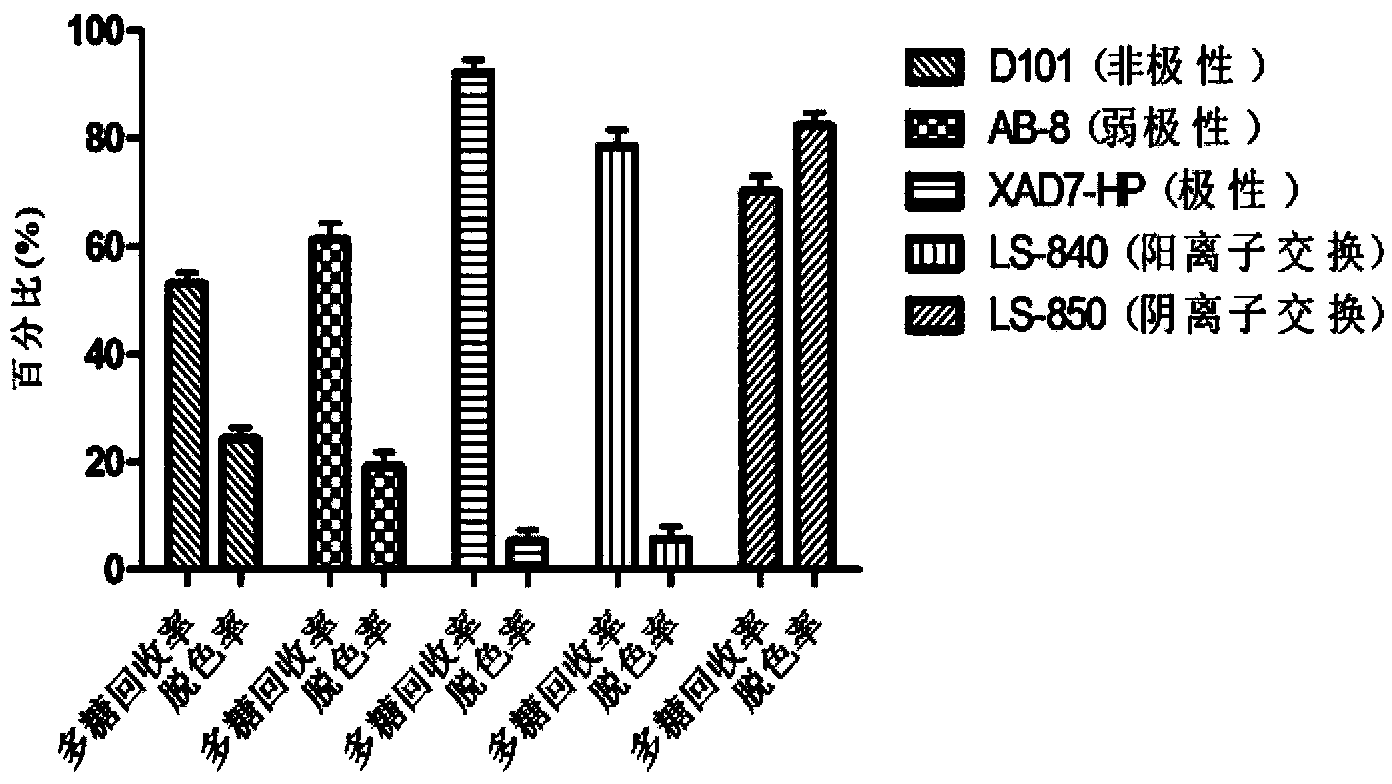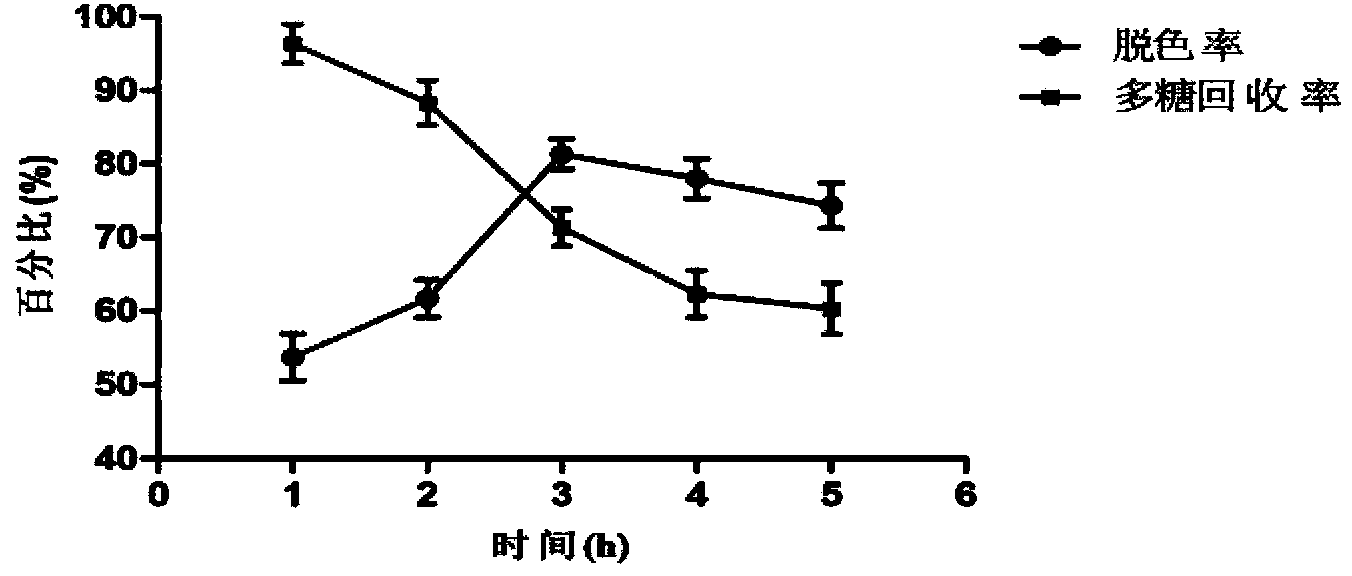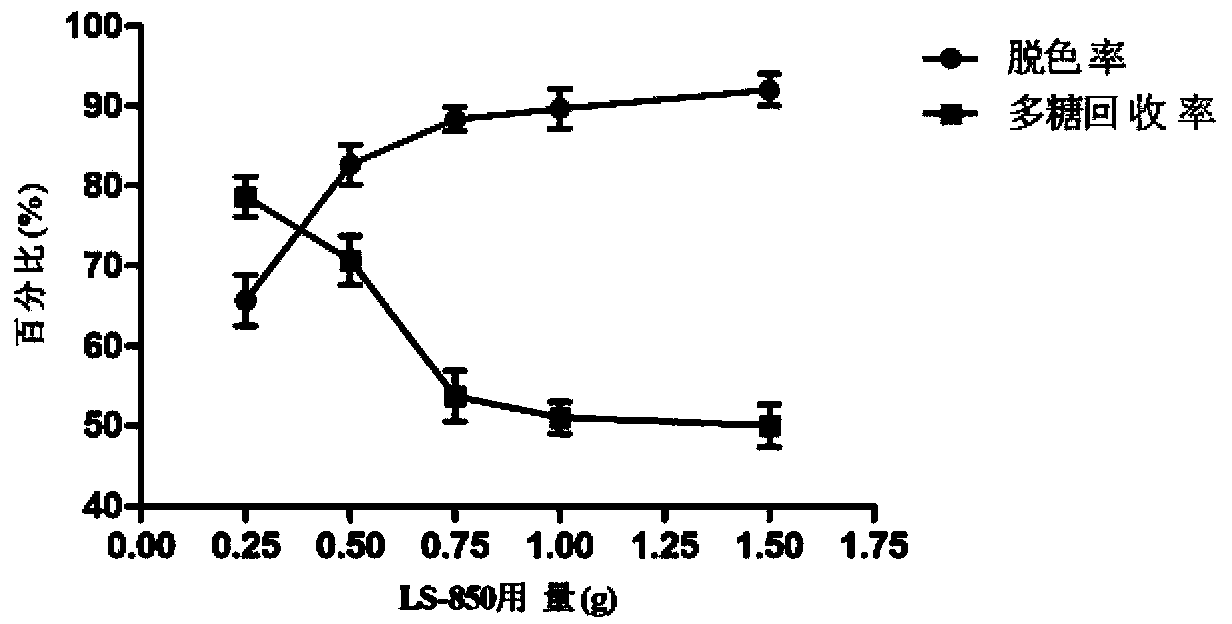Method utilizing ion-exchange resin to decolor crude polysaccharide in ganoderma sinensis submerged fermentation mycelium
A technology of liquid submerged fermentation and ion exchange resin, applied in the field of traditional Chinese medicine chemistry
- Summary
- Abstract
- Description
- Claims
- Application Information
AI Technical Summary
Problems solved by technology
Method used
Image
Examples
Embodiment 1
[0044] Embodiment 1: resin screening
[0045] Take 0.5g of each of the five processed resins, put them into conical flasks with stoppers, add 10ml of refined Zizhi polysaccharide solution to each bottle, place them in a shaker, rotate at 120r / min, keep a constant temperature at 30°C, and shake for 3h. The results are shown in figure 1 .
[0046] The adsorption of macromolecular substances by resin is mainly carried out in two ways: one is the ion exchange between the ions on the resin and the adsorbed substance to adsorb it; The substance is adsorbed. In addition to mainly examining the decolorization rate, the decolorization effect also needs to take into account the index of polysaccharide recovery rate. Depend on figure 1 It can be seen that the decolorization effect of LS-850 anion exchange resin is much better than that of other types of resins (such as figure 1 shown). The anions in LS-850 are exchanged with the pigment anions in Zizhi polysaccharide in the form of ...
Embodiment 2
[0048] Embodiment 2: the impact of decolorization time
[0049] Accurately measure 10ml 5 parts of Zizhi polysaccharide solution, under the same resin dosage LS-8500.5g, temperature 30℃, pH value 6.0, investigate the effect of different time on decolorization, the results are shown in figure 2 .
[0050] Depend on figure 2 It can be seen that with the prolongation of time, the decolorization effect of the resin is obviously enhanced. After 3 hours of LS-850 resin, the decolorization rate begins to increase slowly and has a decreasing trend, indicating that the adsorption and desorption activities of the pigment begin to develop in the direction of dynamic equilibrium. However, the polysaccharide yield basically showed the opposite trend to the decolorization rate, and after 4 hours, the polysaccharide yield almost no longer decreased. In order to remove more pigments in polysaccharides and reduce the loss of polysaccharides as much as possible, considering two indicators c...
Embodiment 3
[0051] Embodiment 3: the influence of resin consumption
[0052] Accurately measure 10ml 5 parts of Zizhi polysaccharide solution, under the same decolorization time of 3h, temperature of 30°C, and pH value of 6.0, investigate the effect of different resin dosage on decolorization, the results are shown in image 3 .
[0053] Depend on image 3 It can be seen that as the amount of resin increases, the decolorization rate shows an upward trend, but when the amount of resin reaches 0.5g, the increasing trend of decolorization rate slows down significantly, and the recovery rate of polysaccharides continues to decline at this time. For subsequent scientific research or further industrial processing, increase the decolorization effect as much as possible while taking into account the higher recovery rate of polysaccharides and reduce the loss rate of polysaccharides, so the resin dosage response surface analysis of the method of the present invention is preferably 0.25g ~ 0.75g ...
PUM
| Property | Measurement | Unit |
|---|---|---|
| recovery rate | aaaaa | aaaaa |
| decolorization rate | aaaaa | aaaaa |
| decolorization rate | aaaaa | aaaaa |
Abstract
Description
Claims
Application Information
 Login to View More
Login to View More - R&D
- Intellectual Property
- Life Sciences
- Materials
- Tech Scout
- Unparalleled Data Quality
- Higher Quality Content
- 60% Fewer Hallucinations
Browse by: Latest US Patents, China's latest patents, Technical Efficacy Thesaurus, Application Domain, Technology Topic, Popular Technical Reports.
© 2025 PatSnap. All rights reserved.Legal|Privacy policy|Modern Slavery Act Transparency Statement|Sitemap|About US| Contact US: help@patsnap.com



